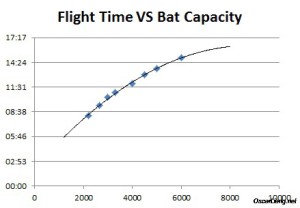Posted by Yangda Security on 9th Apr 2017
GET LONGER FLIGHT TIME ON MULTICOPTER

I get asked a lot, “what’s the flight time on your quadcopter?” It’s hard to answer because it depends on many factors, such as how fast I fly, what battery I use, how windy it is.
In fact, a lot of people are confused by the difference between “flight time” and “hover time”. Some people brag about their “flight time” over xx minutes, which in fact is just hover time. When they really start flying faster and doing acrobatics, their “flight time” drop right down!
Therefore you can’t really compare the “flight time” between 2 different multicopters, it’s not fair as it’s influenced by so many factors. However you can compare the “hover time”. Multicopters with the longest hover time tend to be using very low KV motors with huge propellers, carrying multiple LiPo battery packs.

Anyway, you don’t have to build a gigantic quadcopter to stay longer in the air. In this post we will discuss what impacts battery life, and some of the things you can do to maximize your hover time and flight time.
Flying Style!
Flying around fast, doing flips and rolls etc, will use more power thus shorter flight time. Not saying you should just stay there and hover. If you are doing aerial filming, and want some more time in the air, just fly gently, avoid unnecessary turn arounds or going too fast.
Weight – Payload
As you can probably guess, the simplest and most effective way of increasing your drone’s flight time, would be getting rid of unnecessary weight. Every gram you save is an extra second gained in flight time (not completely true but you get the idea :D ).
Here are a few suggestions for keeping your quad as light as possible:
- make motor/ESC/power wires as short as possible
- avoid using gold bullet connectors
- remove recording camera (GoPro/Mobius) if not using it.
- select light weight components, such as ESC, light weight carbon fibre frame.
Battery
Capacity
One of the most direct factors that affect flight time would be your battery capacity. Of course the bigger battery, the longer flight time you are going to get. But don’t forget the weight of the battery also increases with capacity. So it’s NOT always the bigger the better.
Check out this post about how I choose the optimal battery capacity.
You can also experiment with different sizes batteries, time yourself and find the best.
C-Rating
LiPo Battery C rating not only affects the max continuous current draw, but also flight time in my opinion.
How? Let’s assume, you use up 80% of the battery capacity when the voltage drops to 3.5V per cell. If you have a low C rating LiPo battery, and your multicopter demands more current than the battery can handle, you will notice your battery voltage will start dropping very quickly. In the end, you might only have used 50% of the total capacity when you reach 3.5V per cell. This is a symptom of insufficient C rating, and you will have shorter flight time.
Battery Condition and Maintenance
This could well be a whole new topic, and there is simply too much to cover. But basically, your batteries will get old and the capacity they hold will start diminishing. It’s important that you keep them in good condition, avoid over-discharging them, and drain them up within hours after fully charged. Don’t leave them too long after charged, I usually would put them back to storage voltage (3.8V per cell) if I am not using them within 48 hours.
Motor and Propellers
If you think flight time is more important than power (lift), then by choosing an efficient motor and prop combination will help immensely. You can find out motor efficiency information from the data sheet, or thrust tests done by other hobbyists.
Motor, propeller efficiency is calculated by dividing thrust by power, which is gram per watt (g/W). The higher g/W, the more thrust is generated at a given amount of energy. For example when I am using the Cobra 2204 1960KV motors, I know 6045 props gives me tons of power, but I will get longest flight time, by using 5030 props because of the highest efficiency.
Here is a guide on how to choose propellers and motors.
Also balancing your propellers can increase your flight time too. Unbalanced propellers introduce vibration to your aircraft, not only it uses more energy trying to stabilize it, energy is also wasted on friction between propeller and air.
Motor Braking – ESC Active Braking (or AKA Damped Light)
Active Braking or Damped light is a feature in some ESC firmware, which actively reduces the speed of motor as oppose to slowed down by the air resistance.
Check out this post about Active Braking (end of the post).
With Active braking your multicopter would feel more responsive, which is great for precise flying, racing, and crazy acro moves. However it also uses more power, and therefore shorter flight time for you.
Flight Mode
Although not a very big deal, but flight mode does affect flight time too! Here I mainly refer to Rate mode (AKA manual mode or acro mode) and Self-Level mode (AKA Angle/Horizon mode). To find out the difference, check out this post.
Self-level mode is fantastic, because it helps your control by attempting to keep the quadcopter level. However as it constantly trying to fight with changes of craft attitude, the motors speed are changing very rapidly too. This will uses more energy.
Rate mode doesn’t correct the change of attitude as hard as self-level mode, so in theory it’s more power efficient.
PID tuning!
Just like what we have mentioned above, vibrating aircraft uses more energy. A well tuned, smooth, and stable multicopter is more efficient and gives you longer flight time.
Wind
Wind causes instability to the quadcopter, and the motors have to work harder to correct the errors to stay level. This means that flying in the windy condition uses up battery faster than flying in calm conditions.
LED, FPV Gear? (Electrical Power usage)
Some might wonder how much LED and FPV gear contributes to the falling of flight time, in terms of power usage. In fact it’s not a lot! (although they do also add weight to the copter and decrease flight time, but we are not discussing it here).
LEDs used on multicopters generally only draw 20mA of current, so even at 5V, the power is only 0.1W each LED. If you have 10 LEDs let’s say, that’s 1W in total.
Your FPV gear could draw 0.4A at 12V for example, which is 5W.
Now assume you have a mini quad, at hover 1 single motor draws 8A at 16V (4S), which is 128W, and 512W in total for 4 motors.
LED and FPV gear combined is only less than 1% of the total power usage. Put that in flight time terms, if your flight time is about 5 mins (300 seconds), that’s only 3 seconds that you lost. :)
Source:https://oscarliang.com/maximize-flight-time-quadco...




